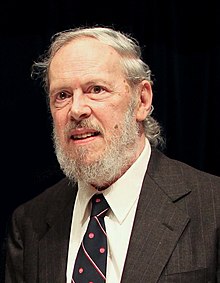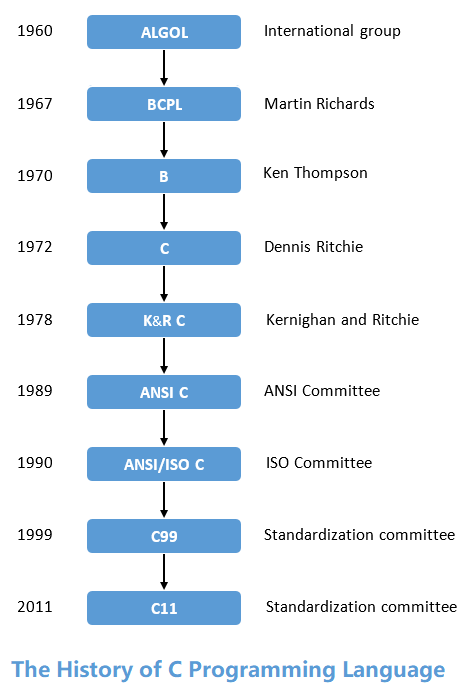The C programming language was developed by Dennis Ritchie at Bell Labs, AT&T in 1972. It was developed to overcome problems with previous languages such as B and BCPL.

The foundation or parent of programming languages is “ALGOL”, which was first introduced in 1960. “ALGOL” was widely used in European countries and introduced the concept of structured programming to the developer community.
In 1967, a new computer programming language was announced as “BCPL”, representing Basic Combined Programming Language. BCPL was designed and developed by Martin Richards, specifically for writing system software.
Just three years later, in 1970, Ken Thompson introduced a new programming language called “B”, which incorporated several features of “BCPL”. This programming language was created at AT&T and Bell Labs using the UNIX operating system. “BCPL” and “B” were both system programming languages.
In 1972, a prominent computer scientist Dennis Ritchie created a new programming language called “C” at Bell Labs. It was created from the “ALGOL”, “BCPL”, and “B” programming languages. The “C” programming language included all the features of these languages and additional concepts that set these languages apart.
The “C” language is a powerful programming language closely related to the UNIX operating system. UNIX operating systems are coded in “C”. Initially, “C” programming was limited to the UNIX operating system, but as it began to spread globally, it became commercialized and many compilers were released for cross-platform systems.
Today, “C” can run on multiple operating systems and hardware platforms. As the language has evolved, it has been released in many different versions. Sometimes, developers find it difficult to keep up with the latest version as systems run on older versions. To ensure that the “C” language remained a standard language, the American National Standards Institute (ANSI) defined the commercial standard for “C” language in 1989. Later, the International Organization for Standardization (ISO) approved the standard in 1990. The language is also known as “ANSI C”, as the standard for C language. Most program development tools from the 1980s to the present generally support syntax that complies with ANSI C.
The concepts and vocabulary of C language are limited and basic programming elements are included. Many later languages, such as C++ and Java, reference C language. It is not an exaggeration to say that C language is the pioneer of modern programming languages, and it has changed the programming world.
The Histroy of C Programming Language

Uses Today
UNIX operating systems are written in C and most of Linux is also in C. Also databases such as Oracle Database, MySQL, MS SQL Server, and PostgresSQL are at least partially written in C. C is the basis of many system kernels. Other programming languages, like Python and Perl, use compilers or interpreters that are written in C.
C has changed over the years and is still a common language to use in lower level programs, like kernels. But it is also used for many applications ranging from device drivers to other programming languages’ compilers or interpreters. The language also made way for C++, Objective-C, C#, and many more C-based languages that each have their own speciality.